
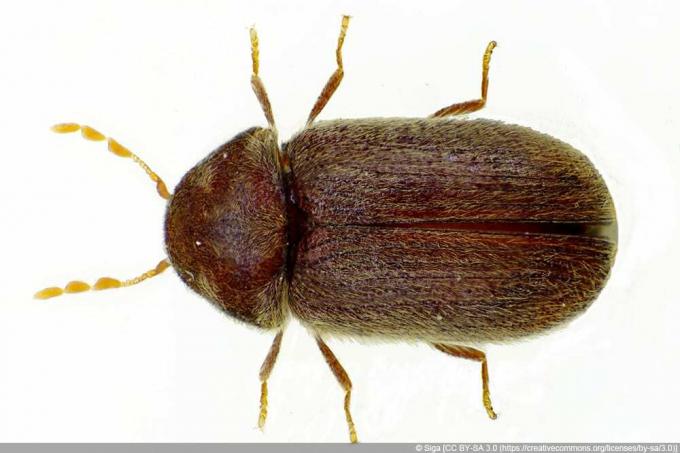
Table of contents
- Brown bugs
- Brown fur beetle
- bread beetle
- grain weevil
- Parquet beetle (Lyctus linearis)
- weevil
They are small, agile and can even fly - the brown beetles that are roaming our homes and apartments. The problem with them: they multiply rapidly and cause damage to inventory and food. Not to mention the disgust. Reasons enough to get rid of them as quickly as possible. But you have to know which beetle it is.
Brown bugs
The term "brown beetles" is a general description of certain types of beetles that are commonly found in apartments and houses. It is chosen because it is often very difficult to determine exactly which beetle it is. As a rule, the following five types are meant:
- Brown fur beetle
- bread beetle
- grain weevil
- parquet beetle
- weevil
All of these animals are so-called culture followers. That means they follow people into the cultural landscape they have created because they promise advantages from it - and this cultural landscape can also be the house or apartment. In fact, the beetles have comfortable living conditions there. They find shelter in a dwelling and also plenty of food.
Brown fur beetle
Characteristics:
- elongated to oval body shape
- 3 to 5 mm long, 2 to 2.5 mm wide
- dark red, brownish-black head, slightly lighter body
- light brown and hairy wings
- reddish to yellow antennae and legs
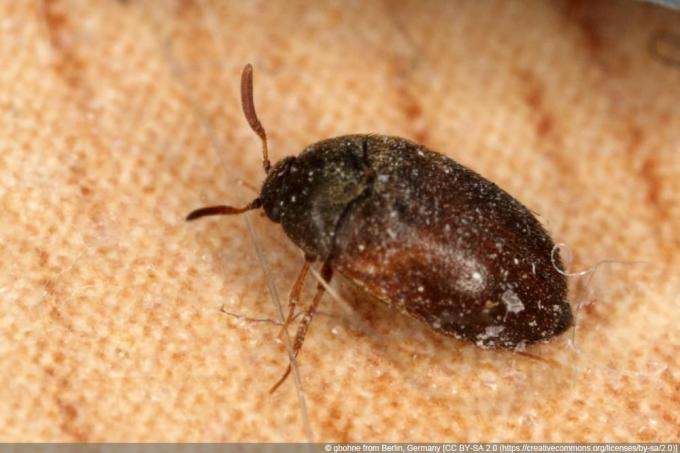
The name already suggests it: the brown fur beetle prefers to nest in furs and clothing made of fabric or fleece. Wool. It is therefore primarily found in the wardrobe. However, the small animals are usually hardly recognizable there, they hide between the clothes and in the cracks of the closet. A clear indication of an infestation, however, are small holes in clothing.
combat
If you have found an infestation, you should treat affected clothing immediately. To do this, they are placed in an oven heated to 60 degrees Celsius for at least an hour. This will kill both the beetles and the larvae. The textiles should then be washed. The closet is thoroughly vacuumed down to the smallest crack.
Tip:
Since the brown fur beetle does not like the smell of essential oils, it is easy to prevent a new infestation. For example, a bag of lavender flowers that you add to the textiles works wonders.
bread beetle
Characteristics:
- elongated, somewhat clumsy body shape
- 3mm long
- reddish-brown coloring
- hairy top
- The head is surrounded by armor like a hood

Bread beetles feed on the dry food stored in the apartment. They prefer to eat bread, uncooked pasta and rice. Consequently, the small animals like to nest where these foods are stored. An infestation can usually only be recognized by the fact that food has been eaten. Incidentally, the bread beetle can fly and often gets into the house through open windows.
combat
Infested food must be disposed of immediately. So that there is no new spread, it is best to put the food immediately in the garbage can outside the house. The affected cupboards, shelves, compartments and vessels should then be thoroughly cleaned with vinegar.
grain weevil
Characteristics:
- slim, oval body
- 3 to 5 mm long
- dark brown body colour
- very pronounced proboscis

Grain weevils and their larvae feed on dry foods such as bread, pasta or rice. The animals therefore prefer to nest in cupboards or shelves. An infestation can usually only be recognized by the food that has been eaten.
combat
All infested food must be disposed of immediately outside the home - in a lockable container. The affected cupboards and shelves as well as any vessels are then thoroughly cleaned with vinegar. It is also advisable to vacuum out cracks with a vacuum cleaner and then dispose of the bag immediately.
Parquet beetle (Lyctus linearis)
Characteristics:
- 2.5 to 5 mm long
- reddish brown to dark brown body
- Pronotum with longitudinal furrow
- hairy, dotted wings
- small mouthparts (biting tools) at the base of the antennae
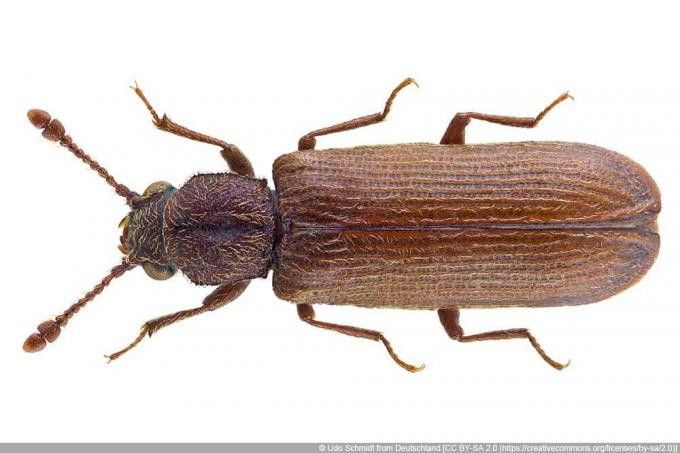
The problem with the parquet beetle are the larvae. They eat with great preference wooden furniture and parquet floors. An infestation can be recognized by damage and small deposits of sawdust, for which there is no other explanation.
combat
To get rid of the larvae relatively high temperatures are required to kill them. Affected furniture and floors must be thermally treated. A layman is usually not able to do this. You should contact an exterminator for this. In most cases, the only thing that helps anyway is to replace the affected elements.
weevil
Characteristics:
- up to 20mm long
- greyish-brown colouration
- very pronounced proboscis
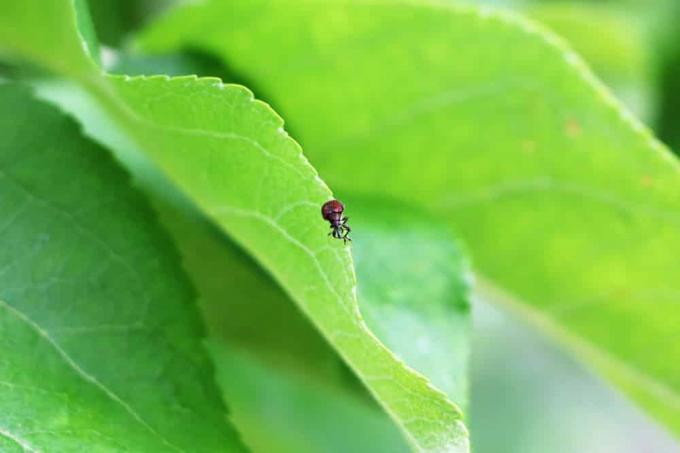
Due to their size, weevils are relatively easy to spot in the home. They pose a threat to all indoor plants because they feed on them. The larvae of the beetle are particularly problematic. They develop in the soil of a plant and feed on its roots there.
combat
Weevils are nocturnal animals and usually move around plants. To combat it, it is therefore sufficient to irradiate the plant with a light source in the dark. The bugs will then play dead and can be easily collected and then disposed of. When repotting, the soil of the plant in question must also be checked in any case. If larvae or eaten roots are found there, the only thing that helps is to dispose of the entire plant substrate.
 Home editorial office
Home editorial office
Learn more about home pests

Red maggots / larvae in the apartment: what to do?
Red maggots in your own home are the ultimate nightmare sight. A few crippling seconds of shock are allowed. But then decisive and effective action must be taken to make them disappear. But who exactly is "the red enemy" and how is the fight fought?

Compost bin powder against maggots: this is how it works
Especially in the warm season they can hardly be avoided: maggots in organic waste. In addition to insecticides, there is a far better way to keep the annoying guests away: powdered organic waste bins. We tell you how to use it and how it works.

Combat earwigs | 5 remedies against earworms in the apartment
Although earwigs, Dermaptera in Latin, are completely harmless and actually useful animals, the insects are still a cause for panic for many people when they appear in the apartment. Here you can find out how to get rid of the unloved crawlers.

Ants in the brickwork: you can do that now
Ants are useful insects, if they are in masonry they can cause damage to an object. An infestation is not easy to recognize, but if the first signs appear, you should act immediately. Simple home remedies are usually sufficient to drive away the insects.

Identify and fight fleas in the home
Even the thought of fleas in the home is uncomfortable. After all, we associate uncleanliness with annoying insects. They are considered carriers of dangerous diseases. Where are you from? What are the signs of a flea infestation? How do you get rid of them?
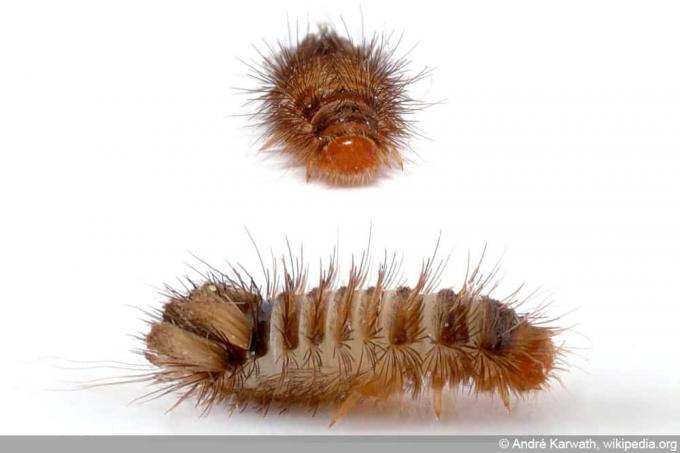
Fighting maggots on the ceiling | 7 tips for all rooms
Bedroom, kitchen or pantry, wall or ceiling - anyone who discovers maggots in the house wants to get rid of them quickly. With our help, you can do it quickly and without professional pest control.



